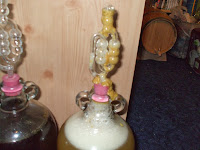After my original "playful" batches as I will call them, I did copious amounts of research and had improved how I both plan and execute my brewing. I have decided to plan my meads and brew them in such a way that the entire brew, from start to finish, is an entirely repeatable exercise so I can improve them for later trials. Originally I was going to start the plain meads last weekend however I stumbled upon the road block of funds (As I wanted to do 4Gal rather than 1 simultaneously) and opted instead for a Bochet.
I've been wanting to do this mead for a while now after reading about it on
Homebrew Talk and decided that this should be the one to start the December brew off with. I already had most of the ingredients for this and even ordered in some vanilla pods to add into the mix too. For those who don't know a Bochet is a "burnt mead". You boil down the mead for over 2 hours until the whole lot becomes black and thicker and doesnt even really bubble up any more. It should give flavours that resemble deep caramels, toffee and even toasted marshmallows (so vanilla should be right at home!).
So here's where I began:
Equipment: 1gal demijohn, 2m plastic tubing for siphoning, airlock and bung, pan for preparing the must, hydrometer, measuring cylinder, very long spoon, cleaning and sterilising powder
Ingredients: Approx 1360g honey, tap water up to 4.5 liters, 2 vanilla pods, high alcohol/dessert yeast.
*Note: The yeast I have been using as advertised as written above. In subsequent brews I shall be using Lalvin yeasts to note the difference between the strains more clearly.
Method: Begin with the obvious and most important step of sterilising everything thoroughly. Next, as said in the opening paragraphs you literally do just dive straight into the seemingly endless process of boiling down all the honey for over 2 hours.
A constant and vigil watch is required over this. If you've ever boiled milk before and let it go a bit too much you'll know how quickly your hob can be covered in frothy, hot milk. Imagine a similar case with honey except it's hotter and stickier and you really really really do not want it touching you... Trust me.

After it has been reduced down I added (gradually <= This is very important too) water to dissolve with the reduced honey and create my must. After I added up to around 1 liter or so I added the vanilla pods too, opened up and seeds scraped out. Siphoning into the demijohn is next. When siphoning at this point I always leave the end of the tube high up in the demijohn and let the must fall freely into it. This aerates the must and gives the yeast more oxygen to begin their fermentation. If you can, even shaking the demijohn can be beneficial; just please ensure the demijohn is properly sealed and you maintain a good grip. After the adding I topped up to level with cold water to balance out the temperature to match the water that I would use to activate the yeast and, after waiting 20 minutes for it, I pitched the yeast giving as an end product what you can see below. This is definitely the darkest coloured mead I will ever make! I haven't been home to check on it since setting it up but I have been informed it is fermenting nicely.

Tests were also conducted on this batch to boot. Before putting into the demijohn I tested the batch with a hydrometer for specific gravity which gave 1.085 (a potential alcohol of 11.3%) however after putting it into the demijohn the fluid level wasn't quite enough. More water was added and SG was retested yielding 1.070/1.075 (a potential alcohol of 9.5%).
As a side note to this post, I have received some post from Italy too... My new oak barrel has arrived ready for me to start using as soon as I get the mead ready for it! Really looking forward to drinking the results before I've even begun! Thanks for reading :)
 1700g of honey, approx 4litres water, ground caramel flavoured coffee (around 4 tablespoons I just threw some in) and 2 vanilla pods, slit and seeds removed and added separately. All of these were added together (holding back 2 liters of water) and brought up to the boil then simmered for 15 minutes. Adding in the extra water I then measured the SG which gave 1.090 which would yield around 12% added a small amount of nutrient (around half a teaspoon) and transferred to the demijohn.
1700g of honey, approx 4litres water, ground caramel flavoured coffee (around 4 tablespoons I just threw some in) and 2 vanilla pods, slit and seeds removed and added separately. All of these were added together (holding back 2 liters of water) and brought up to the boil then simmered for 15 minutes. Adding in the extra water I then measured the SG which gave 1.090 which would yield around 12% added a small amount of nutrient (around half a teaspoon) and transferred to the demijohn. 














